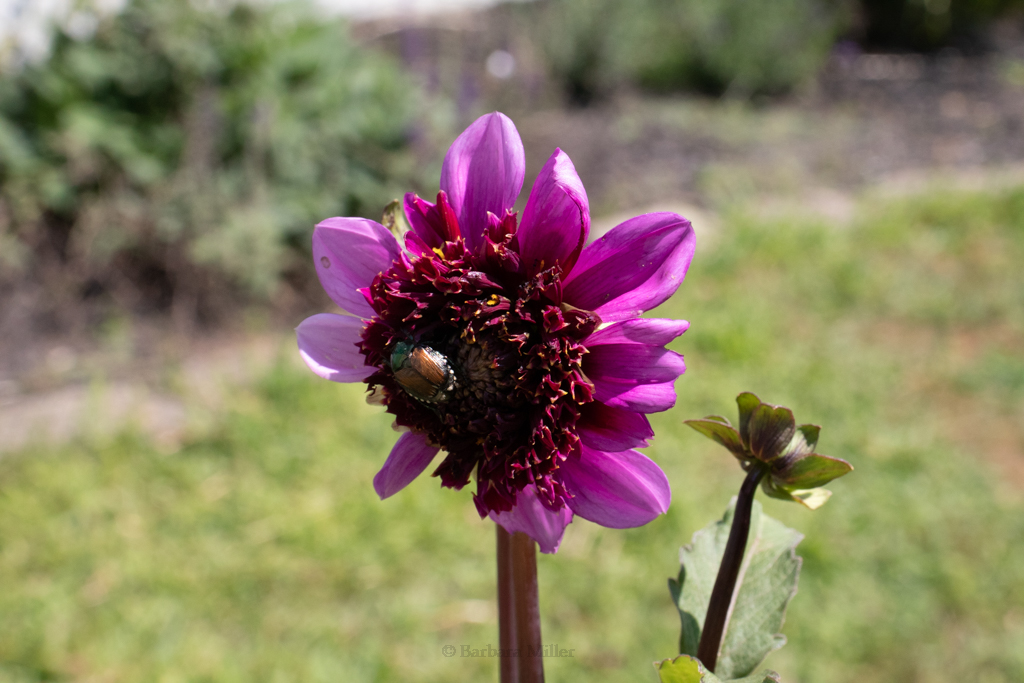I’m really not sure when insects became one of my main focuses when taking photos. I can’t deny that they’ve become a main focus because I have a lot of photos of insects. This focus likely spawned out of my fascination with bees (and pollinators in general) and my love of taking pictures of flowers. You can often find insects on flowers and plants, you know. And both of these things can be found in my yard.
The Japanese beetle, featured in the header photo on a Blue Bayou Anemone Dahlia, is a pest that eats the leaves on plants, leaving the veins behind. This insect is not welcome in my yard but I can’t prevent them from visiting. If your area is plagued with them and you are lucky enough to live in a northern or high-altitude area, you may only have to deal with them every other year. This year they aren’t eating absolutely everything, which is fortunate since the traps seem to be trapping none of them.

The summer azure butterfly, shown here on the flower of a hosta, is not a pest. It is a lovely and tiny pollinator. Butterflies are always welcome, but not many visit. Out of all of the butterflies I’ve encountered, this one seems to be the least skittish.

The katydid, here on the siding of my house, can be considered a pest. I welcome them into my yard since they are unconventional pollinators. While it’s not their intention to pollinate plants, katydids can carry pollen from one plant to another as it hops through the vegetation. The katydid featured here is a male since it is lacking an ovipositor, which is an organ that would be protruding from the back end. He’s probably just hanging out and looking for some ladies.

Another unconventional, or incidental, pollinator is the blue bottle fly, shown here on some Joe Pye weed. While people commonly associate flies with decay and trash, they (the flies, not the people) frequently visit blooming plants and carry pollen from one to the next (which makes the flies more useful than some people). Due to the lack of conventional pollinators in my yard earlier this year, I believe flies are the reason my blueberry bushes were pollinated.

A rather human-phobic pollinator is the yellow swallowtail butterfly. Out of all the butterflies I’ve photographed, this kind tends to keep its distance as much as possible. The yellow swallowtail butterfly trying to hide in this Hakuro-Nishiki willow is a female. You can tell by the orange dots and the not-visible blue pattern on the bottom wings.

As mentioned, the primary focus of my photography is the bee (any variety will do). Pictured here is an eastern carpenter bee enjoying a freshly bloomed hibiscus flower. An eastern carpenter bee can be differentiated from a bumblebee in two obvious ways. The first way is by inspecting the abdomen, which is the lower section. The abdomen of a carpenter bee is shiny while a bumblebee’s abdomen is fuzzy. If you can’t spot the abdomen of the bee, you can check out the thorax. A carpenter bee has a shiny patch on the back, between the wings, while a bumblebee tends to be fuzzy all over. The legs of both bee varieties are fuzzy and adorable. And be sure to check if the bee has full pollen baskets (the yellow patches on their hind legs) just for fun.
I hope you enjoyed these brief descriptions of insects that can be found in my yard. I’m sure I’ll share more in the future.

